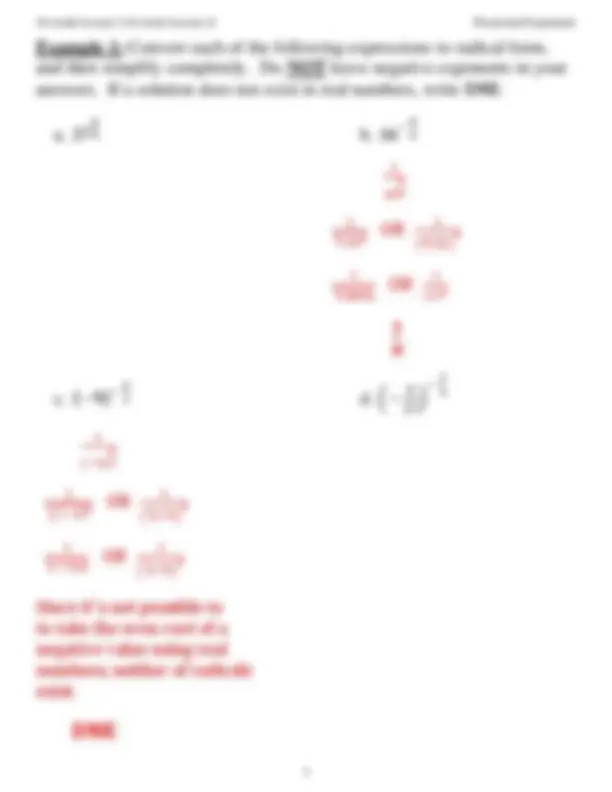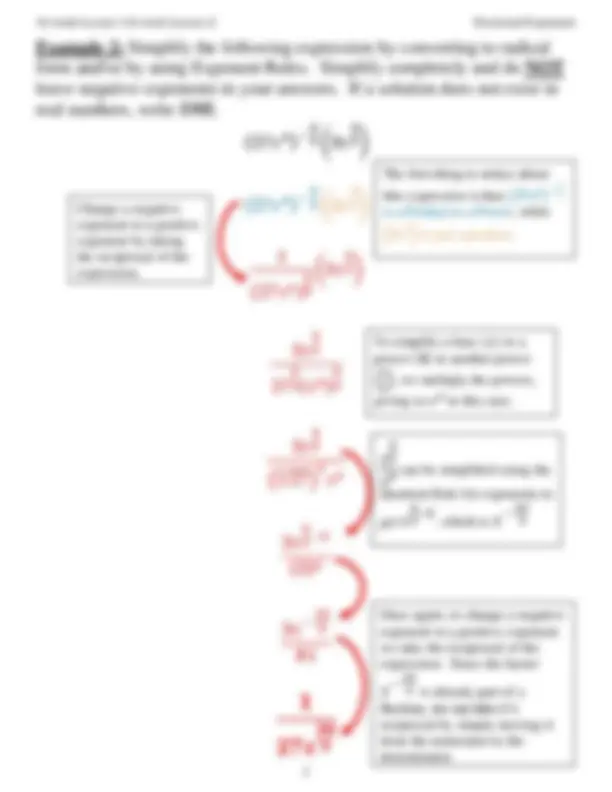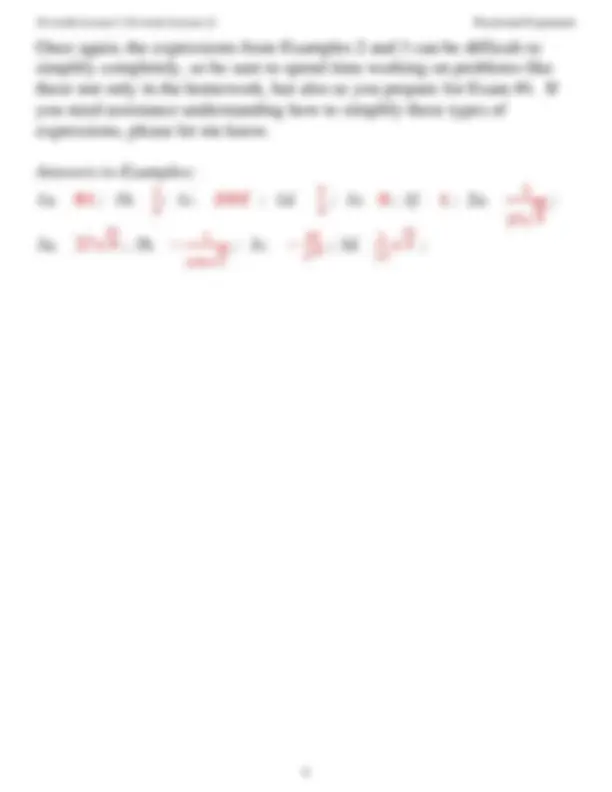






Study with the several resources on Docsity

Earn points by helping other students or get them with a premium plan


Prepare for your exams
Study with the several resources on Docsity

Earn points to download
Earn points by helping other students or get them with a premium plan
Community
Ask the community for help and clear up your study doubts
Discover the best universities in your country according to Docsity users
Free resources
Download our free guides on studying techniques, anxiety management strategies, and thesis advice from Docsity tutors
Instructions on how to convert radical expressions to fractional exponents and vice versa. It includes examples of converting both radicals to exponents and exponents to radicals, as well as simplifying expressions using exponent rules. The document also emphasizes the importance of understanding the concepts from previous lessons, such as the Quotient Rule, Power Rule, and Product to a Power Rule.
Typology: Lecture notes
1 / 8

This page cannot be seen from the preview
Don't miss anything!





In the previous set of notes, we found the following:
Re-writing the radicand 36 as 6
2
, we have the following:
2
How can we re-write a radical (such as a square root) using an exponent?
In other words, 6 to the power of 2 to the power of what will result in 6
1
or just 6. In this case, what exponent is the equivalent of a square root?
2
2
𝑥
1
Using the Power Rule for Exponents, when a base is taken to a power, and
then to another power, the exponents are multiplied. So 2 times what
produces 1?
So the answer is
1
2
. A square root is equivalent to an exponent of
1
2
2
2
𝟏
𝟐
= 6
So a square root is equivalent to a power of
1
2
, which is the reciprocal of
the index 2. The same is true for any radical; to express a radical as an
exponent, we simply need to take the reciprocal of the index of the radical.
Here are a few more examples of radicals and their exponent equivalents.
𝟑
1
3
= 5
𝟒
1
4
2
𝟓
2
1
5
= 𝑦
2
5
(this example uses the Power Rule for Exponents)
Converting a radical ( √
𝑛
) to an exponent (𝑥
1
𝑛
)
base and the reciprocal of the index as the exponent
o the radical expression √𝑥
5
4
is equivalent to
5
1
4
, which
simplifies to 𝑥
5
4
by using the Power Rule for Exponents
o the radical expression ( √
4
5
is equivalent to (𝑥
1
4
)
5
, which also
simplifies to 𝑥
5
4
by using the Power Rule for Exponents
is meaningless
Converting an exponent (𝑥
1
𝑛
) to a radical (
√
𝑛
the exponent as the index of the radical and the base as the radicand
o the expression 𝑥
3
5
can be written as a radical in two ways, both
of which are equivalent
3
5
= √𝑥
3
5
3
5
= ( √
5
3
o regardless of which way you choose to write the radical
expression, the index is the same (in this case 5 )
is meaningless
o √− 9 does not exist with real numbers, so it is meaningless to
write it as
1
2
o also, keep in mind the difference between
1
2
and − 9
1
2
1
2
= √
1
2
= − 1 ∙ 9
1
2
■
■
e. − 4
−
3
2
1
2
1
8
2
3
f. − 32
−
2
5
64
125
−
1
3
−
3
2
1
2
1
2
3
8
2
3
1
4
3
2
1
2
( √
1
3
)
2
( √
8
3
)
2
1
( √
4 )
3
1
2
( 1
)
2
( 2
)
2
1
( 2
)
3
1
2
1
4
1
8
1
8
1
8
1
8
𝟎
f.
Example 2: Simplify the following expression by converting to radical
form and/or by using Exponent Rules. Simplify completely and do NOT
leave negative exponents in your answers. If a solution does not exist in
real numbers, write DNE.
6
−
4
3
( 3 𝑥
4
3
)
6
−
4
3
( 3 𝑥
4
3
)
6
4
3
4
3
)
4
3
4
3 ( 𝑥
6
4
3
4
3
3
4
8
4
3
− 8
4
−
20
3
𝟐𝟎
𝟑
Change a negative
exponent to a positive
exponent by taking
the reciprocal of the
expression.
To simplify a base (𝑥) to a
power
( 6
) to another power
(
4
3
), we multiply the powers,
giving us 𝑥
8
in this case.
𝑥
4
3
𝑥
8
can be simplified using the
Quotient Rule for exponents to
get 𝑥
4
3
− 8
, which is 𝑥
−
20
3
Once again, to change a negative
exponent to a positive exponent
we take the reciprocal of the
expression. Since the factor
−
20
3
is already part of a
fraction, we can take it’s
reciprocal by simply moving it
from the numerator to the
denominator.
The first thing to notice about
this expression is that ( 27 𝑥
6
)
−
4
3
is a Product to a Power, while
( 3 𝑥
4
3
) is just a product.
c. − (
𝑥
3
64
−
4
3
4
−
3
2
𝑥
8
) d. (
𝑥
12
81
3
4
𝑥
9
27
−
2
3
1
4
−
4
5
)
64
𝑥
3
4
3
1
4
3
2
𝑥
8
(𝑥
12
)
3
4
81
3
4
27
𝑥
9
2
3
1
4
1
𝑥
4
5
64
4
3
( 𝑥
3
)
4
3
1
( √
4 )
3
∙𝑥
8
𝑥
9
( √
81
4
)
3
(− 27 )
2
3
(𝑥
9
)
2
3
1
4 𝑥
4
5
( √
64
3
)
4
𝑥
4
1
( 2
)
3
∙𝑥
8
𝑥
9
27
( √− 27
3
)
2
𝑥
6
1
4 𝑥
4
5
( 4
)
4
𝑥
4
1
8 𝑥
8
𝑥
9
27
9
𝑥
6
1
4 𝑥
4
5
256
𝑥
4
1
8 𝑥
8
9 𝑥
9
27 𝑥
6
∙ 4 𝑥
4
5
256
𝑥
4
1
8 𝑥
8
𝑥
3
3 ∙ 4 𝑥
4
5
𝟏𝟐
𝑥
3 −
4
5
12
𝟏𝟐
𝟏
𝟏𝟐
𝟏𝟏
𝟓
Once again, the expressions from Examples 2 and 3 can be difficult to
simplify completely, so be sure to spend time working on problems like
these not only in the homework, but also as you prepare for Exam #1. If
you need assistance understanding how to simplify these types of
expressions, please let me know.
Answers to Examples:
1 a. 81 ; 1b.
1
8
; 1c. 𝐷𝑁𝐸 ; 1 d.
9
4
; 1 e. 0 ; 1f. 1 ; 2 a.
1
27 𝑥
20
3
3a. 27 𝑥
22
15
; 3b. −
1
128 𝑥
13
2
; 3c. −
32
𝑥
12
; 3d.
1
12
11
5
;